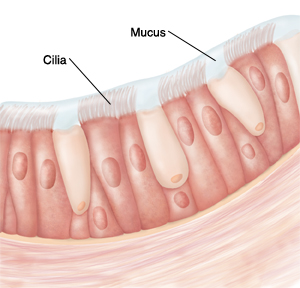Where does a sneeze start? It all starts with a foreign particle that enters and irritates the nasal mucosal lining. This can include dust, pollen, bacteria and even pepper. Your body’s reaction to this foreign particle is a sneeze. The respiratory, nervous and muscular system all work together to expel foreign particles out of your nose. So now a simple sneeze is not so simple. The following steps are the basics of a sneeze that will be further explained throughout the blog:
Respiratory System
-
Starting with the respiratory system, a sneeze starts when a person breathes in a foreign particle. (Most people breathe through their nose to help trap these particles and bacteria).
-
The nose is lined with hair like projections called “cilia” to help trap bacteria and dust particles. Cilia protect bacteria from further traveling down the respiratory system into the lungs. If many cold viruses and other particles do manage to travel down into the lungs, pneumonia can develop and cause other respiratory problems.
-
Other shelf-life projections in the nose called turbinates trap and collect foreign particles. Turbinates are bony projections inside the breathing passage on each side of your nose.
-
People have three turbinates on each side: inferior, middle, and superior.
-
The inferior turbinate is the largest of the three; the superior turbinate is the smallest.
-
Turbinates main function is to prepare the air being breathed in. This includes filtering and trapping foreign particles, warming cold air, and humidifying air to prevent the drying of the bronchial tubes.
-
A nasal mucosal lining lines the turbinates and this is where particles get trapped. This then triggers a reflex arc.
-
Nervous System (see physics of sneezing for more detail)
-
Nerves in the nasal mucosal lining act as the receptor and eyes, nose, lungs, diaphragm and chest muscles act as the effector.
-
Afferent nerves in the nasal passage carry signals to the “sneeze center” to trigger a reaction. The sneeze center is also known as the medulla which is located in the hindbrain. The medulla also controls reflexes such as breathing, vomiting, and digesting. The Trigeminal Nerve is responsible for this.
-
Efferent nerves or motor nerves signal the muscles in the eyes, nose, and chest to contract.
Muscular System/Respiratory System
-
The muscles involved in a sneeze include the eye, abdominal, and chest muscles. The diaphragm and vocal cords are also involved.
-
The muscles in your eyes contract causing eyes to shut automatically.
-
The diaphragm and abdominal muscles work together to force air out of the lungs, nose and mouth at a speed of 100 mph.
-
The diaphragm moves down, lowering pressure in the chest cavity. The lowered pressure causes air to be pulled in to fill the lungs to equalize pressure. Abdominal muscles also aid in breathing.
-
Abdominal muscles such as the intercostals, contract increasing space in the chest.
-
As air is filled in the lungs, the abdominal and intercostals contract again forcing air back out at a high speed.

 7. The air forces mucus and irritant particles out of the nose.
7. The air forces mucus and irritant particles out of the nose.
So Where do these particles end up now? Well, hopefully it won’t be on a fellow classmate, colleague, or neighbor. Mucus is a perfect growing medium for many kinds of bacteria, such as Streptococcus pneumoniae that can cause sinusitis. So please cover up when you cough and sneeze!
-The Sneezeweeze team
Here is a simple and short video on how sneezing occurs.
References:



The way you have linked all the systems together in light of a sneeze is excellent. I can see the big picture!
Maile
This page is very useful and i enjoyed reading it. One suggestion I would like to add, if there is a possibility in adding maybe a video that goes a long with the “physics” of sneezing. Other than that, this page is very helpful. Good job!
Thanks! I was trying to look for the video, but couldn’t really find the “right” one. I found a video that’s very simplified and short, though.